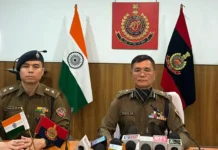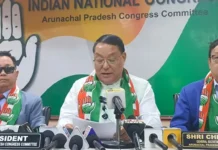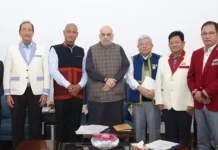[ Sailajananda Saikia ]
The easternmost state of India, Arunachal Pradesh, is distinguished by its many cultures, abundant wildlife, and geopolitical significance within the Indian subcontinent. Among its many physical landmarks, Pangsau Pass is particularly noteworthy due to its historical and geopolitical significance in addition to its natural beauty. Historically used as a commercial route, the pass has drawn attention in recent years when talking about security and economic growth in northeastern India. Pangsau Pass stands out among its many geographical features as a key place of interest, noteworthy for its profound historical and geopolitical significance in addition to its stunning natural beauty. At a high altitude, the pass attracts both nature lovers and adventurers with its breathtaking views of the surrounding landscapes, snow-capped mountains, and lush valleys. In the past, Pangsau Pass has been an essential trading route that has allowed India and its neighbours, including Myanmar, to exchange commodities and cultures. The socioeconomic relationships between the groups living in this border region have been made possible by this connectivity.
Pangsau Pass’s strategic significance has gained attention in recent years, especially in conversations about security and economic growth in northeastern India. In order to promote trade, assist local people, and provide access to healthcare and education, the government is concentrating on improving the infrastructure in this region. The pass also has the potential to grow tourism, which might open up business opportunities and foster mutual understanding and cultural exchange.
Furthermore, it is impossible to overstate Pangsau Pass’s geopolitical importance, particularly in light of India’s connections with its neighbours. The pass will probably influence India’s border security plans and diplomatic interactions in the area as regional dynamics change. Pangsau Pass is a distinctive geographical feature in Arunachal that represents the state’s complex identity in the centre of the Indian subcontinent due to the interaction of its historical significance, economic potential, and geopolitical significance.
Geographical significance
Pangsau Pass is one of the highest mountain crossings in the area, rising astonishingly to almost 3,400 metres (11,155 ft) above sea level. This strategically located pass provides a key point of access into Myanmar from India, creating a crucial conduit for travel and communication between the two countries.
Pangsau Pass is surrounded by a striking but difficult landscape due to its rough topography, which includes steep hills and narrow valleys. This topography adds to the area’s natural attractiveness,in addition to creating challenges for travel and transit. Rich in biodiversity, the area is home to a diverse range of plants and animals that flourish in the distinct microclimates produced by the region’s variable elevation and weather patterns. These climatic conditions sustain rich ecosystems that serve as a testament to the biological value of the region and serve as a habitat for a multitude of species, some of which may be endemic.
As a natural route that links Northeast India and Southeast Asia, Pangsau Pass is also ideally situated. There are many trade and commerce prospects due to this important geographic location. The route has the potential to improve trade relations and economic involvement by making it easier for goods to flow between India and Myanmar. The region has significant potential for economic growth as different parties look for ways to reach markets and invest.
Along with providing opportunities for trade, Pangsau Pass facilitates cross-cultural interactions. People who traverse this natural border contribute a variety of traditions, dialects, and rituals that enhance India’s and Myanmar’s cultural fabric. This exchange has the potential to strengthen ties between the two countries by fostering greater understanding and cooperation amongst communities.
Historical context
Pangsau Pass has historically been an important part of the trade and interaction between different ethnic groups, as this geographical passage has acted as a bridge, connecting these disparate communities and allowing the exchange of goods, ideas, and cultural practices. As a result, the pass has made a significant contribution to the region’s rich and complex cultural mosaic, where customs and lifestyles collide and blend.
Pangsau Pass’ significance dates back to a time when contemporary state borders and territorial demarcations were established, which frequently placed arbitrary barriers on trade and human mobility. In order to facilitate trade in agricultural products, textiles, and other necessities, the pass was a crucial component of several ancient trade routes that wound across the hilly terrain. A common history was created among the participating groups as a result of these early commercial contacts, which promoted both economic cooperation and cultural exchange.
The strategic military and economic significance of Pangsau Pass became more apparent during the British colonial era. The importance of this commercial route was acknowledged by British officials, who saw it as a vital conduit for military supply, in addition to offering access to regional markets. As a vital supply line for the Allied forces during World War II, the pass’s importance reached its zenith. The terrain of the area makes it a vital resource for moving troops and supplies, underscoring Pangsau Pass’s ongoing significance in relation to international trade and conflict.
Geopolitical implications
The relationships between Pangsau Pass and neighbouring countries – China, India, and Myanmar – create a complex tapestry that is reflected in the topographical and geopolitical dynamics surrounding the pass. In addition to being a site of continuous territorial conflicts, this region is also a hotbed for migration and movements of several ethnic groups that cross these international frontiers. At the heart of these dynamics is Arunachal, a major Indian state that shares a large border with China. In this regard, India’s national security plan places a high priority on preserving stability and exercising authority over vital regions like Pangsu Pass. An attentive and proactive approach to governance and security is required due to the possibility of cross-border tensions, management challenges, and threats to sovereignty.
In the context of India’s Look East policy, Pangsau Pass has been a strategic focal point in recent years. This policy aims to deepen economic and political ties with Southeast Asian nations, positioning India more favourably within the broader Indo-Pacific landscape. The Indian government is making a determined effort to build commercial routes and infrastructure that cross Pangsau Pass, which will enable both cultural and economic exchanges with nearby nations. India has a real chance to increase its influence in the Indo-Pacific region as it attempts to normalise trade practices and relax border restrictions in this region. In addition to improving regional connectivity, this programme is important because it counterbalances China’s growing military and economic influence in the same region. In order to maintain its position as a major actor in the changing geopolitical environment of Southeast Asia, India hopes to strengthen regional linkages and increase trade through Pangsau Pass.
Economic opportunities
Bilateral commercial connections between India and Myanmar could be greatly improved by the reactivation of the old trade routes that cross Pangsau Pass. We can clear the path for more seamless and effective trade processes by concentrating on the construction of vital infrastructure in the area, such as roads, bridges, and customs facilities. In addition to enhancing economic relations between the two countries, this strategic move is essential for further integration with the larger Southeast Asian market.
The Kaladan multi-modal transit transport project is an intriguing project in this area that aims to increase connection between the ports of Myanmar and the landlocked areas of Northeast India. This project has the potential to significantly boost the volume of trade that passes through Pangsau Pass by improving logistical capabilities and cutting down on transportation time. By facilitating the flow of products, services, and ideas, the revitalisation and modernisation of these trade routes can strengthen the economic ties between the two nations.
Tourism development
A vital centre of the economy, Pangsau Pass is also a magnificent place with a rich cultural legacy and gorgeous scenery. Significant tourism growth potential exists in this region, especially in the fields of adventure and ecotourism. For the people of Arunachal, we can generate significant economic opportunities by supporting eco-friendly tourism projects that showcase the region’s natural beauty and diverse cultural customs.
Communities can prosper by generating jobs and stimulating local economies through investments in tourism infrastructure, such as visitor centres, lodging, and guided tours. Furthermore, we may promote conservation initiatives and increase public awareness of the environmental issues affecting the region’s distinctive biodiversity by giving eco-tourism top priority.
Increased tourism in the Pangsau Pass region can not only strengthen the local economy but also help tourists develop a deeper understanding of the area’s cultural legacy. This heightened awareness promotes the preservation of regional customs, crafts, and languages, in addition to enhancing the visitor experience. All things considered, increasing tourism in Pangsau Pass has the potential to generate significant financial gains as well as foster a greater awareness and respect for the region’s natural and cultural resources.
Regional development
The significance of enhanced connectivity facilitated by Pangsu Pass stretches far beyond the simple realm of trade; it opens up a pathway for more extensive socioeconomic development in the northeastern state of Arunachal. The improved infrastructure that comes with better connectivity has the potential to transform various aspects of life for the local communities. For instance, it can pave the way for easier access to essential services such as education and healthcare, which are critical components for fostering human capital and improving overall wellbeing.
With better transportation networks and communication facilities, students from remote areas can travel to educational institutions with greater ease, thereby increasing enrollment rates and decreasing dropout rates. Additionally, healthcare facilities can become more accessible, enabling residents to receive necessary medical attention that was previously hard to obtain due to geographical barriers. This, in turn, can contribute to improved health outcomes, leading to a more productive population.
Pangsau Pass is not merely a geographical feature; it stands as a vital nexus where the rich tapestry of history, culture, trade, and geopolitics in Arunachal merges. This pass is steeped in significance, playing an essential role in facilitating interactions between diverse communities and nations. Traditionally, it has been a route of passage for traders, travellers, and cultural exchanges, making it a living testament to the region’s historical legacy and its importance as a bridge between different cultures.
The implications of Pangsau Pass are extensive and far-reaching. On one hand, the potential for economic development in this region is substantial. With its strategic location, the pass could serve as a crucial conduit for trade, connecting markets in India with those in neighbouring countries, and promoting cross-border commerce. Enhanced connectivity could lead to the upliftment of local economies and the creation of new opportunities for small businesses and entrepreneurs. Furthermore, the development of infrastructure in and around Pangsu Pass may pave the way for improved accessibility to remote areas, fostering greater regional integration and facilitating the movement of goods and services.
However, alongside these opportunities lie significant challenges that must be meticulously addressed. The pass raises pertinent security concerns, particularly given the complex geopolitical dynamics in the Indo-Pacific region. As India seeks to assert its presence and influence in this strategic arena, it is imperative to navigate these challenges thoughtfully. Ensuring the security of the pass against potential threats while maintaining open channels for trade and cultural exchange is a delicate balancing act. Additionally, the implications of development must be examined through the lens of sustainability. It is crucial to ensure that economic growth does not come at the expense of environmental degradation or the displacement of local communities.
As we envision the future of Pangsau Pass, it becomes evident that a strategic and holistic approach is necessary. This must involve collaborative efforts among local stakeholders, governmental authorities, and national leaders to engage in balanced and inclusive planning. Local communities should be integral participants in the decision-making processes, ensuring that their needs, aspirations, and cultural values are respected and preserved. At the same time, national interests must be considered to align the development of the pass with broader geopolitical goals.
In conclusion, while Pangsau Pass presents an array of promising opportunities for economic advancement and cultural exchange, it is also fraught with challenges that require careful and considerate address. The journey forward must strive for a harmonious integration of local aspirations and national interests, creating a framework that fosters not only development but also peace, security, and sustainability in this vibrant region. As we move ahead, the stewardship of Pangsau Pass can serve as a model for other regions facing similar dilemmas, showcasing the potential for growth that respects history and embraces a collaborative future. (The contributor is a professor in the geography department of RGU, Rono Hills.)





